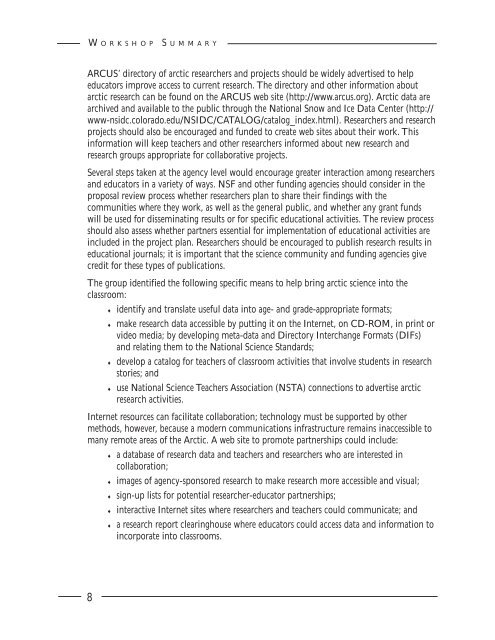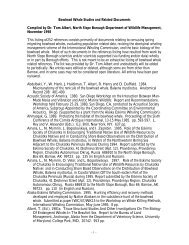ed report 4 page cover - Arctic Research Consortium of the United ...
ed report 4 page cover - Arctic Research Consortium of the United ...
ed report 4 page cover - Arctic Research Consortium of the United ...
Create successful ePaper yourself
Turn your PDF publications into a flip-book with our unique Google optimized e-Paper software.
W O R K S H O P S U M M A R Y<br />
ARCUS’ directory <strong>of</strong> arctic researchers and projects should be widely advertis<strong>ed</strong> to help<br />
<strong>ed</strong>ucators improve access to current research. The directory and o<strong>the</strong>r information about<br />
arctic research can be found on <strong>the</strong> ARCUS web site (http://www.arcus.org). <strong>Arctic</strong> data are<br />
archiv<strong>ed</strong> and available to <strong>the</strong> public through <strong>the</strong> National Snow and Ice Data Center (http://<br />
www-nsidc.colorado.<strong>ed</strong>u/NSIDC/CATALOG/catalog_index.html). <strong>Research</strong>ers and research<br />
projects should also be encourag<strong>ed</strong> and fund<strong>ed</strong> to create web sites about <strong>the</strong>ir work. This<br />
information will keep teachers and o<strong>the</strong>r researchers inform<strong>ed</strong> about new research and<br />
research groups appropriate for collaborative projects.<br />
Several steps taken at <strong>the</strong> agency level would encourage greater interaction among researchers<br />
and <strong>ed</strong>ucators in a variety <strong>of</strong> ways. NSF and o<strong>the</strong>r funding agencies should consider in <strong>the</strong><br />
proposal review process whe<strong>the</strong>r researchers plan to share <strong>the</strong>ir findings with <strong>the</strong><br />
communities where <strong>the</strong>y work, as well as <strong>the</strong> general public, and whe<strong>the</strong>r any grant funds<br />
will be us<strong>ed</strong> for disseminating results or for specific <strong>ed</strong>ucational activities. The review process<br />
should also assess whe<strong>the</strong>r partners essential for implementation <strong>of</strong> <strong>ed</strong>ucational activities are<br />
includ<strong>ed</strong> in <strong>the</strong> project plan. <strong>Research</strong>ers should be encourag<strong>ed</strong> to publish research results in<br />
<strong>ed</strong>ucational journals; it is important that <strong>the</strong> science community and funding agencies give<br />
cr<strong>ed</strong>it for <strong>the</strong>se types <strong>of</strong> publications.<br />
The group identifi<strong>ed</strong> <strong>the</strong> following specific means to help bring arctic science into <strong>the</strong><br />
classroom:<br />
♦ identify and translate useful data into age- and grade-appropriate formats;<br />
♦ make research data accessible by putting it on <strong>the</strong> Internet, on CD-ROM, in print or<br />
video m<strong>ed</strong>ia; by developing meta-data and Directory Interchange Formats (DIFs)<br />
and relating <strong>the</strong>m to <strong>the</strong> National Science Standards;<br />
♦ develop a catalog for teachers <strong>of</strong> classroom activities that involve students in research<br />
stories; and<br />
♦ use National Science Teachers Association (NSTA) connections to advertise arctic<br />
research activities.<br />
Internet resources can facilitate collaboration; technology must be support<strong>ed</strong> by o<strong>the</strong>r<br />
methods, however, because a modern communications infrastructure remains inaccessible to<br />
many remote areas <strong>of</strong> <strong>the</strong> <strong>Arctic</strong>. A web site to promote partnerships could include:<br />
♦ a database <strong>of</strong> research data and teachers and researchers who are interest<strong>ed</strong> in<br />
collaboration;<br />
♦ images <strong>of</strong> agency-sponsor<strong>ed</strong> research to make research more accessible and visual;<br />
♦ sign-up lists for potential researcher-<strong>ed</strong>ucator partnerships;<br />
♦ interactive Internet sites where researchers and teachers could communicate; and<br />
♦ a research <strong>report</strong> clearinghouse where <strong>ed</strong>ucators could access data and information to<br />
incorporate into classrooms.<br />
8




